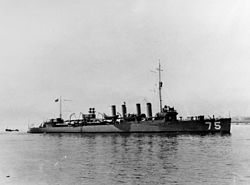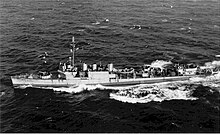Wickes class
|
The Wickes (DD-75)
|
||||||||||||||||
|
||||||||||||||||
|
||||||||||||||||
|
||||||||||||||||
|
||||||||||||||||
The Wickes-class was a class of destroyers in the US Navy . Between 1917 and 1919 111 ships were built at different shipyards. Together with the six destroyers of the Caldwell class and the 156 ships of the Clemson class built later , they formed the so-called flush deck or four stack class .
Only a few Wickes-class ships were finished in time to be used in the First World War . While 29 units were already scrapped in the 1930s when target ships were sunk or sold, the remaining destroyers served in World War II . Most have been converted for other uses, such as light mine layers. As part of the destroyer-for-bases agreement , 22 ships of the Royal Navy and another five units of the Royal Canadian Navy were ceded. Seven of the British destroyers were given to the Soviet Navy after the surrender of Italy in 1944 as compensation for Italian warships . After the end of the war, all ships were scrapped within a few years.
Planning
The torpedo boat destroyer was a response to the threat posed by the torpedo boats for ships of the line that had been newly developed around the world since 1865 . During the Spanish-American War , the need to protect the large warships became so obvious that a commission led by Theodore Roosevelt drafted a report that made the need for this type of ship clear.
During the next few years a number of destroyers were built, the design of which allowed high speed in calm seas. The experiences that were made with these destroyers resulted in the demand for a seaworthy design. The displacement of the destroyers grew steadily between 1905 and 1916 from 450 ts to over 1050 ts. The need to combine high speed with ocean capability led to designs that had oil firing and steam turbines with reducers. Another requirement on the part of the naval command included the use of the ships for reconnaissance purposes. The US Navy had only a few cruisers at the time, but was primarily geared towards ships of the line and destroyers. An investigation report by Captain Sims found that the small destroyers were running out of fuel too quickly and that the maneuvers carried out highlighted the need to have fast, longer-range units.
When the First World War entered its second year and tensions between the USA and the German Empire increased, the USA saw itself forced to further expand the fleet. In the Naval Appropriation Act of 1916, the establishment of a navy was decided to protect both the Atlantic and Pacific coasts. The law allowed the construction of ten battleships , six battle cruisers of the Lexington-class , ten spyware cruisers of Omaha class and 50 destroyers of Wickes class
draft
The requirements for the new class included high speed and the possibility of mass production. The submarine threat that emerged during the First World War required the construction of a large number of destroyers. The maximum speed of 35 knots resulted from the planned missions of the destroyers with the battlecruisers of the Lexington class and the cruisers of the Omaha class .
The final design had a smooth deck and four chimneys. It was a further development of the Caldwell class . General dissatisfaction with the previously built 1000 ton designs, the Cassin and Tucker classes , led to a more complete hull shape with a smooth deck. The greater draft and the smooth deck offered greater rigidity for the hull. In addition, the Wickes class with over 24,000 hp had around 5,000 hp more than the Caldwell class , which resulted in an increase in speed of 5 knots. The greater performance of the machine required around 100 t more weight for the drive system. The design had a straight keel and propeller shafts running almost horizontally to minimize weight.
The armament corresponded to the Caldwell class . With four 4 ″ / 50 guns on single mounts, the artillery was typical of destroyers of that time. The torpedo armament, however, was unusually strong with twelve 21 ″ torpedo tubes, according to American doctrine of the time.
The range of the Wickes destroyer was short. It turned out that the bridge and guns were very wet, which limited their use. The following Clemson class was able to bunker an additional 100 tons of fuel, but the real solution to the range problem lay in the development of refueling at sea.
construction
In 1916, Congress approved the construction of 50 destroyers. The success of the German submarines led to the construction of 111 destroyers. The ships were built by Bath Iron Works (8), Bethlehem Steel Corporation 's Fore River Shipbuilding Company (26), Union Iron Works (26), Mare Island Navy Yard (8), Newport News Shipbuilding (11), New York Shipbuilding ( 10) and William Cramp and Sons (21) built; in addition, a destroyer of the class was built at the Charleston Navy Yard . The construction of the destroyers was considered so important that work on the cruisers and battleships was postponed to complete the destroyer program. As the first Wickes-class ship , the USS Little was launched in Quincy on November 11, 1917. Five more ships had been launched by the end of the year. The peak of production was in July 1918, when 17 destroyers were launched - 15 of them on July 4th.
After the war ended, the program continued, and 21 Wickes destroyers were launched after the armistice on November 11, 1918 . The last Wickes-class destroyer , USS Crowninshield , was launched on July 24, 1919. Through the construction program (with the following Clemson class) the US Navy owned so many destroyers that no new ones were built by 1932.
period of service
US Navy
Some Wickes destroyers were completed in time to be used in World War I. They drove in the battle fleet and in convoy service. No ship was lost. The class's first losses were in 1921. USS DeLong ran aground in 1921, and USS Wolsey sank after a collision.
From the end of the First World War, the US Navy drew the conclusion that minefields unexpectedly released by fast ships could be very effective against enemy operations. The large number of flush-deckers, mostly completed after the end of the war, led to the conversion of fourteen Wickes- class destroyers into fast mine-layers . On July 17, 1920, fourteen ships of the class were renamed "destroyer minelayers". There were seven ships from Fore River Shipbuilding in Quincy (Mass,) with USS Stribling , Murray , Israel , Luce , Maury , Lansdale and Mahan (ex-DDs 96-102) as well as seven destroyers from the Union Iron Works in San Francisco with USS Hart , Ingraham and Ludlow (ex DDs 110-12) and Burns , Anthony , Sproston and Rizal (ex-DDs 171-174), which were now used as DM-1 to DM-14 . The four triple torpedo tube sets were removed and replaced with rails that could hold up to 80 mines. In 1921 all renovations were completed. But by mid-1922, quite a few of the new mine-layers were assigned to the reserve. At the end of 1930 six mine-layers were completely eliminated, the remaining eight followed in 1936/37. To
replace them, four more Wickes destroyers built by Newport News Shipbuilding were converted into mine layers in 1930/31 . The following destroyers of the Wickes class, converted to mine-layers, were used in World War II and were built in all four Newport News: 1930 → USS Gamble (DM 15, ex DD-123) and Ramsay (DM 16, ex DD-124 , most recently AG-98) as well as 1931 Montgomery (DM 17, ex DD-121) and Breese (DM 18, ex DD-122), both of which came back into the reserve in 1937, but after the outbreak of war in Europe in 1939 again as mine layers in Service came. The four ships survived the world war.
When the other eight mine-laying destroyers of the first series also took place in 1936, they were replaced by four ships of the Clemson class.
In the 1930s, 23 destroyers of the class had been scrapped, sold or sunk as a target ship. Some were also downgraded to auxiliary ships. The reduction was also a result of the fleet contracts signed by the USA, which otherwise would not have allowed a new destroyer to be built.
From 1940, conversions into rapid troop transports (ID: APD ) based on the model of the → USS Manley , of which APD-2 to -9, -14 to -17, -19 to -22 and APD-25 from 16 destroyers of the Wickes - Class emerged.
From the end of 1940, flush deckers converted into minesweepers came into service with the US Navy, of which DMS-1 to -8 and DMS-18 were also made from nine Wickes- class destroyers , see USS Lamberton (DMS-2) .
Thirteen destroyers of the class were lost or not repaired in American service during World War II. The remaining ships were scrapped between 1945 and 1947.
As the first American ship of the class, the USS Jacob Jones (DD-130) was lost on February 28, 1942 off the American east coast by torpedoes from U 578. The search for survivors could only find twelve crew members. This was followed by the losses of the Colhoun (DD-85 / APD-2), Gregory (DD-82 / APD-3) and Little (DD-79 / APD-4) in the battle for Guadalcanal.
Other naval forces
22 Wickes destroyers were handed over to the British Royal Navy . The Royal Canadian Navy took over five more under the Destroyers for Bases Agreement . Most of these surrendered destroyers were equipped similarly to the US destroyers and were mainly used as escorts. The USS Buchanan , put into service by the British as HMS Campbeltown , was disguised as a German ship, used in Operation Chariot against the dry dock of Saint-Nazaire .
With the Bath used under the Norwegian flag, another destroyer of the class was lost in the war. The remaining ships were scrapped between 1944 and 1947.
In 1944 the British awarded seven destroyers of the class to the Soviet Navy . They were replacements for Italian warships that the Soviet Union claimed for itself after the capitulation of Italy . These ships survived the war and were scrapped between 1949 and 1952.
Trivia
The fictional mine sweeper destroyer USS Caine (DMS-21) from the novel The Caine Was Her Fate (English: The Caine Mutiny ) by Herman Wouk is a flush decker converted into a mine sweeper .
literature
- Norman Friedman: US Destroyers An Illustrated Design History . Naval Institute Press, 2004, ISBN 1-55750-442-3 .
- Paul H. Silverstone: US Warships of World War I . Ian Allan, 1970, p. 118-124 .
- Paul H. Silverstone: US Warships of World War II . Doubleday and Company, 1968, p. 112, 212, 215, 276, 303 .
- John Campbell: Naval Weapons of World War Two . Naval Institute Press, 1985, ISBN 0-87021-459-4 .
Web links
- WICKES destroyers (1918–1921) on Navypedia
- Flush Decker homepage with pages on individual ships, conversion programs, etc.
- Destroyers Wickes class
- Dictionary of American Naval Fighting Ships - Index
- Wickes I (Destroyer No. 75)



